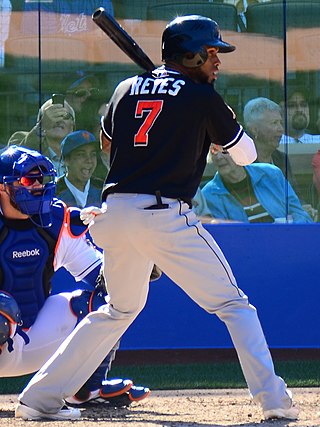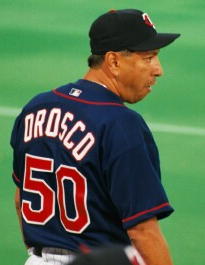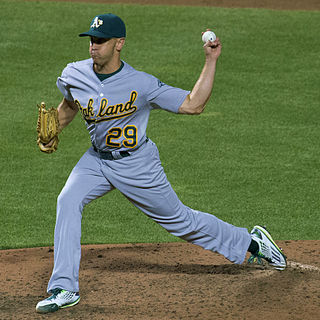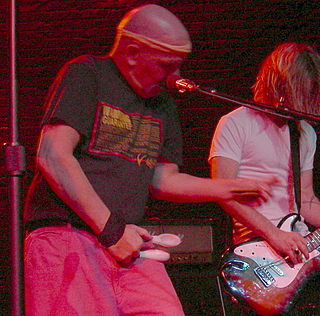
Accordions are a family of box-shaped musical instruments of the bellows-driven free reed aerophone type. The essential characteristic of the accordion is to combine in one instrument a melody section, also called the diskant, usually on the right-hand manual, with an accompaniment or Basso continuo functionality on the left-hand. The musician normally plays the melody on buttons or keys on the right-hand side, and the accompaniment on bass or pre-set chord buttons on the left-hand side. A person who plays the accordion is called an accordionist.

Mickey Charles Mantle, nicknamed "the Mick" and "the Commerce Comet", was an American professional baseball player. Mantle played his entire Major League Baseball (MLB) career (1951–1968) with the New York Yankees, primarily as a center fielder. Mantle is regarded by many as being one of the best players and sluggers of all time. He was an American League (AL) Most Valuable Player three times and was inducted into the Baseball Hall of Fame in 1974.
Ambidexterity is the ability to use both the right and left hand equally well. When referring to objects, the term indicates that the object is equally suitable for right-handed and left-handed people. When referring to humans, it indicates that a person has no marked preference for the use of the right or left hand.

Left-hand traffic (LHT) and right-hand traffic (RHT) are the practices, in bidirectional traffic, of keeping to the left side or to the right side of the road, respectively. They are fundamental to traffic flow, and are sometimes referred to as the rule of the road. The terms right- and left-hand drive refer to the position of the driver and the steering wheel in the vehicle and are, in automobiles, the reverse of the terms right- and left-hand traffic. The rule also extends to where on the road a vehicle is to be driven, if there is room for more than one vehicle in the one direction, as well as the side on which the vehicle in the rear overtakes the one in the front. For example, a driver in an LHT country would typically overtake on the right of the vehicle being overtaken.

In baseball, a switch hitter is a player who bats both right-handed and left-handed, usually right-handed against left-handed pitchers and left-handed against right-handed pitchers, although there are some exceptions.

In baseball, a left-handed specialist is a relief pitcher who throws left-handed and specializes in pitching to left-handed batters, weak right-handed batters, and switch-hitters who bat poorly right-handed. Because baseball practices permanent substitution, these pitchers frequently pitch to a very small number of batters in any given game, and rarely pitch to strictly right-handed batters. Most Major League Baseball (MLB) teams have several left-handed pitchers on their rosters, at least one of whom is a left-handed specialist. A left-handed specialist is sometimes called a LOOGY, coined by John Sickels, and may be used pejoratively.

An outfielder is a person playing in one of the three defensive positions in baseball or softball, farthest from the batter. These defenders are the left fielder, the center fielder, and the right fielder. As an outfielder, their duty is to catch fly balls and ground balls then to return them to the infield for the out or before the runner advances, if there are any runners on the bases. As an outfielder, they normally play behind the six players located in the field. By convention, each of the nine defensive positions in baseball is numbered. The outfield positions are 7, 8 and 9. These numbers are shorthand designations useful in baseball scorekeeping and are not necessarily the same as the squad numbers worn on player uniforms.

Howard Michael Johnson, nicknamed HoJo, is an American former professional baseball third baseman. He played for the Detroit Tigers, New York Mets, Colorado Rockies, and Chicago Cubs of Major League Baseball (MLB) from 1982 to 1995. He is third on the Mets' all-time lists for home runs, runs batted in, doubles, and stolen bases. He also played for the Rockland Boulders of the Canadian-American Association of Professional Baseball. On July 13, 2007, he was promoted from his position as the Mets' first base coach to their hitting coach which he held until the end of the 2010 season. From 2014 to June 2015, he was the hitting coach of the Seattle Mariners after starting 2013 as the batting instructor for the Tacoma Rainiers, the Mariners' Triple-A affiliate.
Footedness is the natural preference of one's left or right foot for various purposes. It is the foot equivalent of handedness. While purposes vary, such as applying the greatest force in a certain foot to complete the action of kick as opposed to stomping, footedness is most commonly associated with the preference of a particular foot in the leading position while engaging in foot- or kicking-related sports, such as association football and kickboxing. A person may thus be left-footed, right-footed or ambipedal.

In baseball, the lefty-righty switch is a maneuver by which a player who may be at a disadvantage against an opponent of a certain handedness is replaced by a substitute who is better suited for the situation.
Cross-dominance, also known as mixed-handedness, hand confusion, or mixed dominance, is a motor skill manifestation in which a person favors one hand for some tasks and the other hand for others, or a hand and the contralateral leg. For example, a cross-dominant person might write with the right hand and do everything else with the left one, or manage and kick a ball preferentially with the left leg.
Overall, being mixed handed seems to result in better performance than being strongly handed for sports such as basketball, ice hockey, and field hockey. What these sports have in common is that they require active body movements and also an ability to respond to either side. The situation is reversed for racquet sports such as tennis. Individuals with crossed hand-eye preference seem to be much better at gymnastics, running, and basketball because of the way in which congruent and crossed sided individuals position their bodies.
A platoon system in baseball or American football is a method for substituting players in groups (platoons), to keep complementary players together during playing time.

The flare is an acrobatic move in which the performer alternates balancing the torso between either arm while swinging the legs beneath in continuous circles. It is a fundamental b-boying/bgirl power move, and in gymnastics it may be performed on a pommel horse or during the floor exercise. The move is commonly spelled flair in gymnastics and further may be called a "Thomas flair" after its originator, Kurt Thomas.

Greg Allen Harris is an American former professional baseball pitcher, who played in Major League Baseball (MLB) for 15 years (1981–1995), Harris pitched in 703 career games, starting 98. He pitched for the San Diego Padres in the 1984 World Series, which they lost to the Detroit Tigers in five games.

Canne de combat is a French combat sport. As weapon, it uses a canne or cane designed for fighting. Canne de combat was standardized in the 1970s for sporting competition by Maurice Sarry. The canne is very light, made of chestnut wood and slightly tapered. A padded suit and a fencing mask are worn for protection.

In baseball, a switch-pitcher is an ambidextrous pitcher who is able to pitch with either the right or left hand from the pitcher's mound.

Patrick Michael Venditte Jr. is an American former professional baseball pitcher. He played in Major League Baseball (MLB) for the Oakland Athletics, Toronto Blue Jays, Seattle Mariners, Los Angeles Dodgers, San Francisco Giants, and Miami Marlins. After attending Creighton University, Venditte was drafted by the New York Yankees in 2008. He signed with the Athletics as a free agent before the 2015 season and made his MLB debut that year.

Spoons can be played as a makeshift percussion instrument, or more specifically, an idiophone related to the castanets. They are played by hitting one spoon against the other.

A switch hit is a modern cricket shot. A switch hit involves the batter effectively changing from a right-hander to a left-hander just before the ball is delivered by the bowler for the purpose of executing the shot. It is a variation of the reverse sweep, in which the hands on the bat handle are switched and the stance is changed during the bowler's delivery action, and has been compared to switch-hitting in baseball.
Bias against left-handed people is bias or design that is usually unfavorable against people who are left-handed. Handwriting is one of the biggest sources of disadvantage for left-handed people, other than for those forced to work with certain machinery. About 90 percent of the world's population is right-handed, and many common articles are designed for efficient use by right-handed people, and may be inconvenient, painful, or even dangerous for left-handed people to use. These may include school desks, kitchen implements, and tools ranging from simple scissors to hazardous machinery such as power saws.













